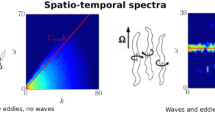Abstract
The ergodicity defect, a relatively new approach for analyzing fluid flows, is presented. The technique combines tools and concepts from ergodic theory and wavelet theory, and we briefly consider this theoretical background. The ergodicity defect provides a measure of the complexity of individual fluid particle trajectories and this measurement is used to identify Lagrangian coherent structures in the flow. Results for both idealized and realistic ocean flows are compared and contrasted with other methods for identifying coherent structures. Other possible applications for the technique are also discussed.
Access this chapter
Tax calculation will be finalised at checkout
Purchases are for personal use only
Similar content being viewed by others
References
Aref H. Stirring by chaotic advection. J Fluid Mech. 1984;143:1–21.
Birkhoff G. Proof of the ergodic theorem. Proc Natl Acad Sci. 1931b;17:656–60.
Daubechies I. Ten Lectures on Wavelets CBMS-NSF Reg. Conf. Ser. Appl. Math. Soc. Ind. Appl. Math, Philadelphia; 1992.
Debnath, L. Wavelet transforms and their applications. Boston: Birkhauser; 2002.
Froyland G, Padberg K, England M, Treguier A. Detection of coherent oceanic structures via transfer operators. Phys Rev Lett. 2007;98:1–4.
Grassberger P, Procaccia I. Measure the strangeness of strange attractors. Phys D. 1983;9:189–208.
Haller G, Sapsis T. Lagrangian coherent structures and the smallest finite-time Lyapunov exponent. Chaos. 2011;2:1–7.
Kuznetsov L, Jones C, Toner M, Kirwan AD Jr. Assessing coherent feature kinematics in ocean models. Phys D. 2004;191:81–105.
Lasota A, Mackey M. Chaos, fractals and noise. Applied Mathematical Science 97. Berlin:Springer; 1994.
Lekien F, Shadden SC, Marsden JE. Lagrangian coherent structure in n-dimensional systems. J Math Phys. 2007;48:1–19.
Madrid JA, Mancho AM. Distinguished trajectories in time dependent vector fields. Chaos. 2009;19:1–18.
Malhotra N, Mezić I, Wiggins S. Patchiness: a new diagnostic for Lagrangian trajectory analysis in fluid flows. J Bifurc Chaos. 1998;8:1053–94.
Mane R. Ergodic theory and differentiable dynamics. New York: Springer-Verlag; 1987.
Mathew G, Mezić I. Metrics for ergodicity and design of ergodic dynamics for multi-agent systems. Phys D. 2011;240:432–42.
Mathew G, Mezić I, Petzold L. A multiscale measure for mixing and its applications. Phys D. 2005;211:23–46.
Mezić I. Caltech PhD Thesis; 1994
Mezić I, Wiggins S. A method for visualization of invariant sets of dynamical systems based on the ergodic partition. Chaos. 1999;9:213–8.
Oliver M. Special issue on applications of wavelets in the geosciences. Math Geosci. 2009;41:609–10.
Petersen K. Ergodic theory. Cambridge: Cambridge University Press; 1983.
Poje AC, Haller G, Mezić I. The geometry and statistics of mixing in aperiodic flows. Phys Fluids. 1999;11:2963–8.
Rypina I, Scott S, Pratt LJ, Brown MG. Investigating the connection between complexity of isolated trajectories and Lagrangian coherent structures. Nonlinear Proc Geophys. AQ12011;977–87.
Scott SE. Different perspectives and formulas for capturing deviation from ergodicity. SIAM J Appl Dyn Syst. 2014;124:1889–947.
Scott SE. Characterizing and capturing ergodic properties of random processes with a focus on geoscience applications. Submitted to IEEE Transactions on Information Theory
Scott SE, Redd C, Kutznetsov L, Mezić I, Jones C. Capturing deviation from ergodicity at different scales. Phys D Nonlinear Phenom. 2009;238:1668–79.
Shadden SC, Lekien F, Marsden JE. Definition and properties of Lagrangian coherent structures from finite-time Lyapunov exponents in two-dimensional aperiodic flows. Phys D. 2005;212:271–304.
Shchepetkin AF, McWilliams JC. The regional ocean modeling system: a split-explicit, free-surface, topography following coordinates ocean model. Ocean Model. 2005;9:347–404.
Sturman R, Ottino J, Wiggins S. The mathematical foundations of mixing. Cambridge: Cambridge University Press; 2006.
Tupper PF. Ergodicity and the numerical simulation of Hamiltonian systems. Submitted
Walnut D. An introduction to wavelet analysis. Boston: Birkhauser; 2002.
Walters P. Introduction to ergodic theory. New York: Springer; 1982.
Author information
Authors and Affiliations
Corresponding author
Editor information
Editors and Affiliations
Rights and permissions
Copyright information
© 2015 Springer International Publishing Switzerland
About this chapter
Cite this chapter
Scott, S. (2015). Analyzing Fluid Flows via the Ergodicity Defect. In: Balan, R., Begué, M., Benedetto, J., Czaja, W., Okoudjou, K. (eds) Excursions in Harmonic Analysis, Volume 3. Applied and Numerical Harmonic Analysis. Birkhäuser, Cham. https://doi.org/10.1007/978-3-319-13230-3_6
Download citation
DOI: https://doi.org/10.1007/978-3-319-13230-3_6
Published:
Publisher Name: Birkhäuser, Cham
Print ISBN: 978-3-319-13229-7
Online ISBN: 978-3-319-13230-3
eBook Packages: Mathematics and StatisticsMathematics and Statistics (R0)




